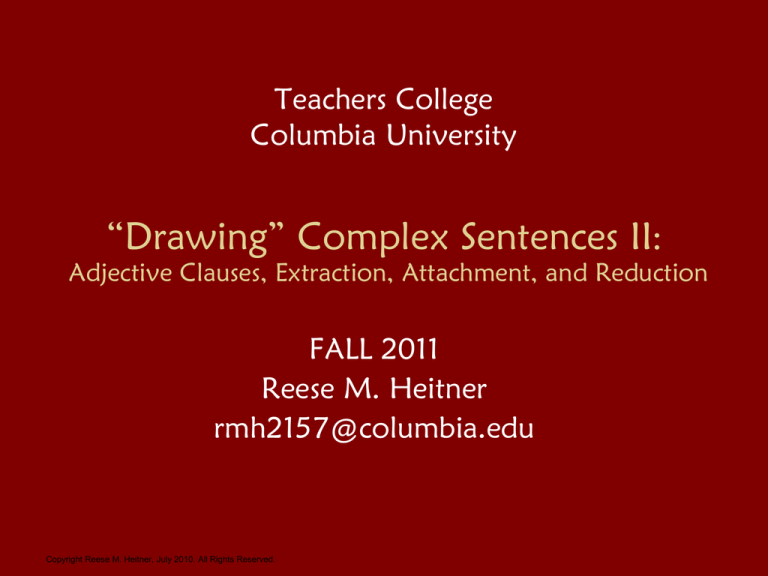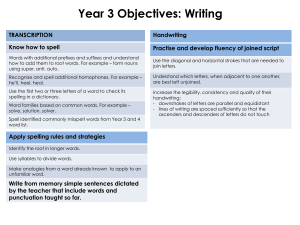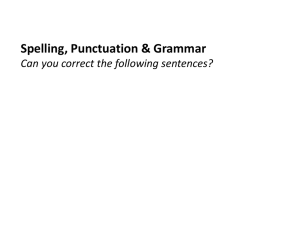
Teachers College
Columbia University
“Drawing” Complex Sentences II:
Adjective Clauses, Extraction, Attachment, and Reduction
FALL 2011
Reese M. Heitner
rmh2157@columbia.edu
Copyright Reese M. Heitner, July 2010. All Rights Reserved.
“Drawing” Complex Sentences
Advanced grammar students are routinely confronted
with the challenge of writing, revising, and proofreading
multi-clause sentences.
“Drawing” Complex Sentences
I need structure in my life!!!
“Drawing” Complex Sentences
Visualize It!
Clause A
Connector
Clause B
“Drawing” Complex Sentences
3 Connectors
(Swales & Feak, 2004, pp. 27- 29, 177-178;
Hogue, 2003, pp. 30-53, 278-284)
Subordinators:
(Hogue, 2003, pp. 42-53)
Adverbial Clause Subordinators of Time
(When, After, Before, Since, etc.)
Adverbial Clause Subordinators of Reason
(Because, If, Although, Since, etc.)
Adjective (Relative) Clause Subordinators
(Who, Whom, Whose, Where, etc.)
Noun Clause Subordinators
(That, What, How, Who, Where, etc.)
Coordinators:
And, But, Yet, Or, Nor, So, etc.
(Hogue, 2003, pp. 32-40)
Transitionals:
However, Consequently, By contrast, etc.
(Hogue, 2003, p. 301-306) (one-word), -ly adverbs, prepositional phrases
“Drawing” Complex Sentences
Adjective Clauses
(Hogue, 2003, pp. 186-191)
(1)
.
The students copied the teacher WHO was explaining the text.
Main
Clause
Sub
Clause
.
“Drawing” Complex Sentences
(1)
The students copied the teacher WHO was explaining the text.
RP
(2)
The students WHO were explaining the text were understood.
.
RP
(3)
The students wrote the sentence WHICH the teacher explained.
RP
(4)
.
The students WHOM the teacher taught passed.
RP
.
.
“Drawing” Complex Sentences
(1)
WHO was explaining the text.
The students copied the teacher WHO
(1a)
(1b)
(1a) The students copied the teacher. (1b) The teacher was explaining the text.
Adjectives Clauses are based upon Noun-Noun Repetition
“Drawing” Complex Sentences
Reconstructing N-N Repetition
(1a)
The students copied the teacher. The teacher was explaining the text.
(1b)
The students copied the teacher. The teacher was explaining the text.
(1c)
The students copied the teacher
(1d)
S
V
O
WHO
RP
was explaining the text
Aux
V
(O)
.
.
“Drawing” Complex Sentences
Relative Clause
Basic Pattern 1:
S V O RP VP (O)
The students copied the teacher WHO was explaining the text.
Basic Pattern 1:
S V O RP VP (O)
“subject-extraction/object-attachment”
“Drawing” Complex Sentences
Reconstructing N-N Repetition
(2a) The students were understood. The students were explaining the text.
(2b)The students were understood. The students were explaining the text.
(2c) The students
WHO
(2d)
RP
S
were explaining the text
Aux
V
O
were understood
VP
.
.
“Drawing” Complex Sentences
Relative Clause
Basic Pattern 2:
S RP VP O VP
The students WHO explained the sentence were understood.
Basic Pattern 2:
S RP VP O VP
“subject-extraction/subject-attachment”
“Drawing” Complex Sentences
Reconstructing N-N Repetition
(3a) The students wrote the sentence. The teacher explained the sentence.
(3b) The students wrote the sentence. The teacher explained the sentence.
(3c) The students wrote the sentence
(3d)
S
V
O
WHICH
RP
the teacher explained
S
V
t
t
.
.
“Drawing” Complex Sentences
Relative Clause
Basic Pattern 3:
S V O RP S V
The students wrote the sentence WHICH the teacher explained.
Relative Clause
Basic Pattern 3:
S V O RP S V
“object-extraction/object-attachment”
“Drawing” Complex Sentences
Reconstructing N-N Repetition
(4a)
The students passed. The teacher taught the students.
(4b)
The students passed. The teacher taught the students.
(4c)
The students
WHOM
(4d)
S
WHOM
the teacher taught
S
V
t
passed
t
VP
.
.
“Drawing” Complex Sentences
Relative Clause
Basic Pattern 4:
S RP S V VP
The students WHOM the teacher taught passed.
Relative Clause
Basic Pattern 4:
S RP S V VP
“object-extraction/subject-attachment”
“Drawing” Complex Sentences
Subject-Extraction Patterns
(1)
The students copied the teacher WHO was explaining the text.
S
(2)
V
O
RP
Aux
V
O
The students WHO were explaining the text were understood.
S
RP
V
O
V
.
.
“Drawing” Complex Sentences
Subject-Extraction Reductions
(Swales & Feak, 2004, pp. 59-64)
(1)
The students copied the teacher WHO was explaining the text.
S
(2)
V
O
RP
Aux
V
O
The students WHO were explaining the text were understood.
S
RP
Aux
V
O
V
.
.
“Drawing” Complex Sentences
Subject-Extraction
Reduction Patterns
(1)
The students copied the teacher explaining the text.
S
(2)
V
O
V-ing
O
The students explaining the text were understood.
S
V-ing
O
V
.
.
“Drawing” Complex Sentences
Object-Extraction Patterns
(3)
The students understood the sentence WHICH the teacher explained.
S
(4)
V
O
O
S
The students WHOM the teacher taught passed.
S
O
S
V
V
.
V
.
“Drawing” Complex Sentences
Object-Extraction Reductions
(3)
The students understood the sentence WHICH the teacher explained.
S
(4)
V
O
O
S
The students WHOM the teacher taught passed.
S
O
S
V
V
.
V
.
“Drawing” Complex Sentences
Object-Extraction
Reduction Patterns
(3)
The students understood the sentence the teacher explained.
S
(4)
V
O
The students the teacher taught
S
S
V
S
passed.
V
.
V
.
“Drawing” Complex Sentences
Split MC Patterns
(2)
The students WHO explained the sentence were understood.
S
(4)
RP
V
O
V
The students WHOM the teacher taught passed.
S
RP
S
V
V
.
.
“Drawing” Complex Sentences
Linear MC Patterns
(1)
The students copied the teacher WHO was explaining the text.
S
(3)
V
O
RP
.
VP
The students wrote the sentence WHICH the teacher explained.
S
V
O
RP
S
V
.
“Drawing” Complex Sentences
Key Terms
Main Clause: “split” vs. “linear”
Attachment: subject vs. object
Extraction: subject vs. object
“Drawing” Complex Sentences
Guess the Pattern
(MC)
(A)
S
(E)
S
(S)
The talk
V
S
V
we attended
V
is almost over
.
.
.
.
Split
SubjectAttachment
Object-Extraction
Reduction
Correct!
“Drawing” Complex Sentences
Guess the Pattern
(MC)
(A)
(E)
(S)
S
V
S
V
O
O
They answered the speaker
V
O
asking the questions
.
.
.
.
Linear
ObjectAttachment
SubjectExtraction
Reduction
Correct!
“Drawing” Complex Sentences
Advanced Issues
Deletion of RP when object of Preposition:
1.
2.
3.
4.
We left the lecture WHICH we had heard enough of.
We left the lecture of WHICH we had heard enough.
We left the lecture WHICH we had heard enough of.
We left the lecture of WHICH we had heard enough.
Subject-Extracted RP “to be” conversion to Progressive for Reduction:
1.
2.
3.
4.
The room emptied of people who needed a break.
The room emptied of people who
a break.
The room emptied of people who were needing a break.
The room emptied of people needing a break.
Nonrestrictive (“nonessential”) versus Restrictive (“essential”) (Hogue, 2003, p. 190):
1. My wife, who is nice, will inherit my wealth.
1. My wife who is nice will inherit my wealth.
2. The students, whom we saw, were late.
2. The students whom we saw were late.
3. Hawaii, the only island state, is beautiful.
3. Hawaii the only island state is beautiful.
RULE:
Use commas if the the referent is ALREADY UNIQUE. The relative clause is NOT essential.
Do NOT use commas when the referent needs selection. The relative clause is “essential.”
“Drawing” Complex Sentences
By visually exploiting the abstract grammatical geometry of
multi-clause constructions, instructors and advanced students
are encouraged to approach complex sentences in terms of
architectural templates.
Advantages:
+ recognize the similarities/differences among basic relative clause constructions
+ identify incorrect constructions by attending to Noun-Noun repetition
+ understand subject vs. object extraction, attachment, movement, and reduction
Disadvantages:
– overly analytic, based upon syntax not semantics
– overly visual, based upon detecting abstract patterns
– overly technical, based upon “extraction” and “attachment”
“Drawing” Complex Sentences
Questions?
Main Clause
Adjective Clause
RP
RP
.
.








